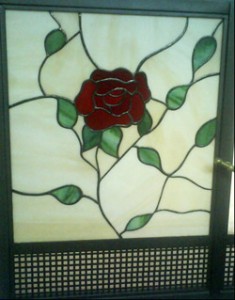 Use of stained glass in architecture
Use of stained glass in architecture
First article in the series
Stained glass – an artistic technique that combines colorful glass parts to a masterpiece
This article deals with the history of stained glass art.
The article explains how this art evolved in different periods and changed accordingly from time to time, to the present day.
Stained-glass art began in medieval Europe during the Romanesque period , when the people built splendid churches. The builders at the time combined works of stained glass as an attempt to revive the ancient Roman style.
The art of stained glass culminated in the Gothic period, this time is characterized by the construction of cathedrals in every major city. The cathedralwas built as a symbol of the kingdom of Christ. The climax came in the construction of tall cathedrals where little construction material was used. This enabled the creation of huge windows integrated into stained glass. The role of decorations in the windows was educational, in which the stories of the Old and New Testaments were told. These windows produced a colorful light that gave worshippers a heavenly experience.
At the end of the Middle Ages, with the prosperity of Renaissance art, some stained-glass work was abandoned in favor of visual art, namely sculpture and painting, which became the most effective tool for the Church for the study of believers.
Stained glass in the modern era
In the late 19th and early 20th centuries stained glass art returned to prosper with the development of art nouveau style and arts and crafts style. These design styles dealt with applied art, such as the creation of knickknacks and furniture, whose inspiration is flora and fauna. Stained glass occupied a central place as a means of design expression, and was integrated into the various accessories such as headboards, reading lamps, vases and more.
The Art of Stained Glass in the Land of Israel
At the beginning of the settlement in Israel , a great deal of integration was made into stained-glass works, because the first architects brought with them from Europe both the styles of construction and the art of the time. Among the most prominent buildings is the national library building in Givat Ram, which boasts a huge stained glass wall by the Israeli artist Mordechai Ardon.
In the 1960s-80s, stained glass windows were integrated into stained-glass windows in synagogues, public buildings such as hospitals and courts, and educational institutions. Today, stained glass is commonly used not onlyin public construction, but alsoin private housesand apartments, where windows are integrated as various knickknacks.
In the next article, I will elaborate on how to use stained glass in private construction
Article by Nira Kimhi, stained glass artist www.niravitrag.co.il
Additional articles on similar topics:
Interior design with ease - the living room
5 main ingredients for home renewal
Types of flooring and cladding - tiles and marble
Types of flooring and cladding - parquet boards
Use of stained glass in architecture
Interior design as added value
Israeli Design - Local Design Style
Contact us – To coordinate a consultation
And you can of course call me by phone: 050-9847484
wwww.efratmeiri.co.il






2 thoughts on "using stained glass in architecture"